One...
Basically the issue you face is the tweeters resonant frequency and its effect on the tweeters impedance and peak to peak excursion. As you go lower in freq. the tweeter, due to the units mass, stiffness of its suspension, and whatever mechanical damping it may have, will resonate at some point. Many tweeters will have a resonant freq some where between 500Hz and 1.5Khz.
At the resonant freq. the tweeters impedance rises . This means that your crossover no longer sees the resistance it needs to work properly, and is allowing too much power into the tweeter. The result is you end up with a freq. response that does not follow the 6 db roll off, AND a bunch of power fed into a wimpy voice coil and suspension that was not designed to move that far.
Some tweeters use mechanical damping to lower the resonant peak and keep a more linear impedance through this region so that when a crossover is used close to the resonant freq. it will still work ok. This damping is sometimes a ferro fluid in the voice coil gap. And sometimes its done using a suspension that has a less "springy" quality. If everything is balanced just right this can work. Some will say however there seems to be a subjective quality to damping like this that is not as high class for lack of a better way to describe it, as a unit without this damping. Great debate potential here 😉
Yes distortion is an issue and that is a tricky subject as different types and placement of these distortion products seem to affect our perception quite a bit. In my own experience ( mostly with developing ribbons) I find that the distortion figures so many are passionate about are not nearly as much of a problem as we( including myself at one time 😉 ) want to believe. I suspect again its the type/ placement/and amount that matters. It just seems more complex than a simple number.
I have ribbons prototypes used from 1khz on up were almost exactly the same ribbon diaphragm design can go from 3-4 % distortion at around 1 khz, 95db , down to .3-.4% with a slight change in design. I have yet to find anyone who can hear the difference. My suspicion is that at low levels both are "low distortion" and at higher levels our hearing is less sensitive to it so we dont necessarily hear it all that well. Just a guess.
I like the ribbons largely because I have a truly flat response down through the low crossover region due to the linear impedance. And no strong diaphragm or suspension induced breakup modes throughout . The resonant freq. of these is around 100hz and its a mild rise at that so I can use a second order cross with no issue, or even a 1st order crossover( at lower volumes).
Anyway the domes have a very different motor/ suspension and there are a number of issues with using a low order filter that doesn't cut the energy sharply enough to avoid. The biggest issue is the rise in impedance and the rise in peak to peak excursion at resonance. If the resonance is damp well enough you might get away with a 6db cross BUT you will likely still need a "conjugate" network to flatten the impedance enough to get it all to work, AND you will likley need to cross over high ( above 3k) to avoid melting the voice coil and or moving the voice coil outside its linear magnet field even at moderate listening levels.
Basically the issue you face is the tweeters resonant frequency and its effect on the tweeters impedance and peak to peak excursion. As you go lower in freq. the tweeter, due to the units mass, stiffness of its suspension, and whatever mechanical damping it may have, will resonate at some point. Many tweeters will have a resonant freq some where between 500Hz and 1.5Khz.
At the resonant freq. the tweeters impedance rises . This means that your crossover no longer sees the resistance it needs to work properly, and is allowing too much power into the tweeter. The result is you end up with a freq. response that does not follow the 6 db roll off, AND a bunch of power fed into a wimpy voice coil and suspension that was not designed to move that far.
Some tweeters use mechanical damping to lower the resonant peak and keep a more linear impedance through this region so that when a crossover is used close to the resonant freq. it will still work ok. This damping is sometimes a ferro fluid in the voice coil gap. And sometimes its done using a suspension that has a less "springy" quality. If everything is balanced just right this can work. Some will say however there seems to be a subjective quality to damping like this that is not as high class for lack of a better way to describe it, as a unit without this damping. Great debate potential here 😉
Yes distortion is an issue and that is a tricky subject as different types and placement of these distortion products seem to affect our perception quite a bit. In my own experience ( mostly with developing ribbons) I find that the distortion figures so many are passionate about are not nearly as much of a problem as we( including myself at one time 😉 ) want to believe. I suspect again its the type/ placement/and amount that matters. It just seems more complex than a simple number.
I have ribbons prototypes used from 1khz on up were almost exactly the same ribbon diaphragm design can go from 3-4 % distortion at around 1 khz, 95db , down to .3-.4% with a slight change in design. I have yet to find anyone who can hear the difference. My suspicion is that at low levels both are "low distortion" and at higher levels our hearing is less sensitive to it so we dont necessarily hear it all that well. Just a guess.
I like the ribbons largely because I have a truly flat response down through the low crossover region due to the linear impedance. And no strong diaphragm or suspension induced breakup modes throughout . The resonant freq. of these is around 100hz and its a mild rise at that so I can use a second order cross with no issue, or even a 1st order crossover( at lower volumes).
Anyway the domes have a very different motor/ suspension and there are a number of issues with using a low order filter that doesn't cut the energy sharply enough to avoid. The biggest issue is the rise in impedance and the rise in peak to peak excursion at resonance. If the resonance is damp well enough you might get away with a 6db cross BUT you will likely still need a "conjugate" network to flatten the impedance enough to get it all to work, AND you will likley need to cross over high ( above 3k) to avoid melting the voice coil and or moving the voice coil outside its linear magnet field even at moderate listening levels.
Last edited:
lowmass: I get this now. It has to be measured, monitored and listened to or for. If you don't reach problematic areas, meaning the driver holds together and is behaving from an electrical and mechanical perspective, you are left with possibly or not, distortion issues. Just like there are cone breakup or ringing and sibilance issues which may or may not cause problems.
Which bring me to the most valuable piece of knowledge I have regarding loudspeakers: Everyone is doing an educated guess and everyone is winging it, seeking their own personal best. Most of what a loudspeaker engineer does is implementing his/her interpretation of what sounds decent, good or excellent. The engineer is no better than his/her latest masterpiece.
VituixCAD is on my list to learn and start using soon. This thread made it much easier to just jump in headfirst and making executive decisions for my first loudspeaker build. So far everything has been a mix of load of theoretical studying and listening sessions to commercial loudspeakers. Now is the time to take the first step to becoming a loudspeaker engineer.
🙂
Which bring me to the most valuable piece of knowledge I have regarding loudspeakers: Everyone is doing an educated guess and everyone is winging it, seeking their own personal best. Most of what a loudspeaker engineer does is implementing his/her interpretation of what sounds decent, good or excellent. The engineer is no better than his/her latest masterpiece.
VituixCAD is on my list to learn and start using soon. This thread made it much easier to just jump in headfirst and making executive decisions for my first loudspeaker build. So far everything has been a mix of load of theoretical studying and listening sessions to commercial loudspeakers. Now is the time to take the first step to becoming a loudspeaker engineer.
🙂
Always good to find a proven design like SEAS Njord:
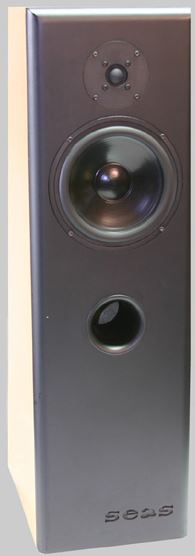
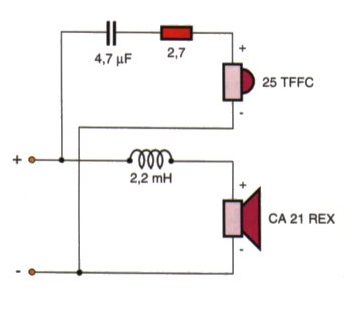
Most SEAS 8" woofers and 1" tweeters should work with that idea. The second order tweeter solution would add a 0.2mH shunt coil after the series cap and possibly put 2.2R in front of the circuit rather than 2.7R after.
About 3kHz crossover just because of the natural rolloff of a 8" bass. Which shouldn't faze most good tweeters.
Most SEAS 8" woofers and 1" tweeters should work with that idea. The second order tweeter solution would add a 0.2mH shunt coil after the series cap and possibly put 2.2R in front of the circuit rather than 2.7R after.
About 3kHz crossover just because of the natural rolloff of a 8" bass. Which shouldn't faze most good tweeters.
Last edited:
The CA21REX woofer is no longer available and I am happy kits exist for them who don't want to experiment, play around and learn, but rather just want a developed project - I actually want to learn, develop and get my hands dirty 🙂
About 3kHz crossover just because of the natural rolloff of a 8" bass. Which shouldn't faze most good tweeters.
Hi Steve!
I'm currently running Monacor DT-75/8 tweeters (8 ohm; ferrofluid damped; Fs = 2,000Hz) via a 2.2uF polyprop and a variable L-pad.
They sound OK to me in my old MS100s, coupled with their 5" midwoofers, which are run direct and have a natural roll-off of 6dB per octave at 5,000Hz.
DT-75/8
There's about an octave of overlap, and the tweeters are at least 12dB down at their resonant frequency.
I did experiment with a 0.26mH coil in parallel with the tweeter but was not happy with the resulting sound.
Does this mean my ears prefer 1st order crossovers? Your words of wisdom please!
That MS100 resembles my old MS15 (Mordaunt Short) speakers, no? 😀
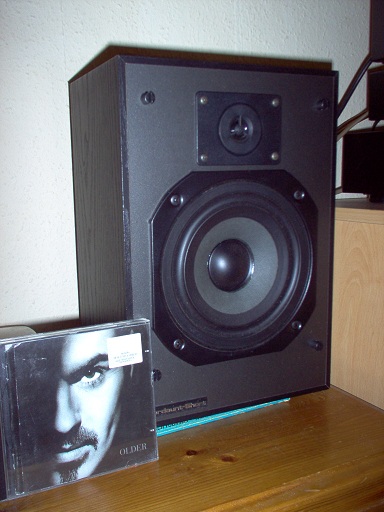
That audax style tweeter was actually FR optimised to work with a single cap around 2uF.
TBH, you have to model these things to know what is going on with phase and frequency response. Sometimes it just goes all wrong with certain filters. Sometimes it all falls into place.
They ended up like this with a quite complicated filter, but the box was always too small. Which is why I was interested in that big 450uF series capacitor on the bass idea recently.
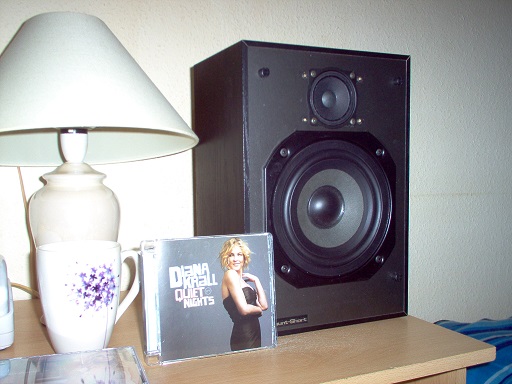
The easy speaker to do first order is 5" polycone. It is quite flat and time alignment is good. Like this:
Peerless HDS PPB 830860
I'd think you need a different tweeter from the XT25 style though. XT25 needs a good higher order crossover. TBH, first order is a good starting project with good driver selection, but never goes loud or undistorted like higher order.
That audax style tweeter was actually FR optimised to work with a single cap around 2uF.
TBH, you have to model these things to know what is going on with phase and frequency response. Sometimes it just goes all wrong with certain filters. Sometimes it all falls into place.
They ended up like this with a quite complicated filter, but the box was always too small. Which is why I was interested in that big 450uF series capacitor on the bass idea recently.
The easy speaker to do first order is 5" polycone. It is quite flat and time alignment is good. Like this:
Peerless HDS PPB 830860
I'd think you need a different tweeter from the XT25 style though. XT25 needs a good higher order crossover. TBH, first order is a good starting project with good driver selection, but never goes loud or undistorted like higher order.
Guy's, if you need to stroke each others back, please do so via PM or in another thread 🙂 Its not nice to hack someone's thread.
Thanks Steve.
I don't play loud and don't notice any distortion at the levels at which I listen.
I have followed your MS15 renovation with interest and have noted the changes you made to its crossover. The MS15 was based on the larger, real wood veneered MS100, which ran its midwoofer full range and advertised that as a selling point!
The Monacors were chosen simply because they were the only tweeters easily available that would fit the available space and cover the fixing holes of the original Audax tweeters (which had stopped tweeting loudly enough, possibly due to the ferofluid becoming gummy!)
I don't play loud and don't notice any distortion at the levels at which I listen.
I have followed your MS15 renovation with interest and have noted the changes you made to its crossover. The MS15 was based on the larger, real wood veneered MS100, which ran its midwoofer full range and advertised that as a selling point!
The Monacors were chosen simply because they were the only tweeters easily available that would fit the available space and cover the fixing holes of the original Audax tweeters (which had stopped tweeting loudly enough, possibly due to the ferofluid becoming gummy!)
We're just friendly here. 🙂
Oneminde, have you formulated any specific ideas where you are going on this?
It's all about ideas. Tempered by experience which says that certain drivers, like 6", are just plain difficult. Breakup and time alignment and high woofer inductance can scupper many schemes.
Oneminde, have you formulated any specific ideas where you are going on this?
It's all about ideas. Tempered by experience which says that certain drivers, like 6", are just plain difficult. Breakup and time alignment and high woofer inductance can scupper many schemes.
🙂 Its not nice to hack someone's thread.
I posed Steve a question about a first order crossover and he kindly answered it.
I suggest that we were on thread!
Well... since 70-80% of a loudspeaker is a guessing game, I just have to jump into it. I have nice tools available just like other engineers, but lack real life experimentation. So basically, I need to select a few drivers and take it from there.Oneminde, have you formulated any specific ideas where you are going on this?
With limited real life scenarios, I can't say anything more. In part due to the fact that certain theoretical material simply don't make sense until you see the effects in real life and in part because I have lived in an ideal world, I can't say whether something holds water or not
That's where I am 🙂
That's okay... as long as it does not turn into specific projects since this is about general 1st order and drivers - Yes I do get that specific loudspeakers can be used to describe the matter. But I am happy to announce that I get what is required: measurements.I posed Steve a question about a first order crossover and he kindly answered it.
I suggest that we were on thread!
I can move on - but the thread or debate can continue ... I will stay and read/comment ofc 🙂
It seems to me you have Michael Chua and 6" Vifa polycone and Morel CAT 378, which looks good. Or Joachim Gerhard (indirectly) with SEAS DXT and U22, which is a glorified SEAS Njord.
Both should work well enough, mainly because of excellent driver selection and some time alignment cleverness involved.
Both could be later adjusted for higher order. Because if a speaker can hold first order together, it will do even better with a good filter. Just how it works.
FWIW, Michael and Joachim are people of considerable ability and huge experience.
Finch (Morel CAT378 + Vifa PL18W0-09-08) - AmpsLab
Sonics by Joachim Gerhard cabinets and kits.
I don't think you can cover every aspect of first order in a thread. It's a waste of time to write some sort of textbook that will quickly disappear into oblivion. A good first order, or 6dB slope design can actually have a huge and complex crossover. Series or parallel. And, in fact, the acoustic slopes only rarely come out at 6dB/octave.
Both should work well enough, mainly because of excellent driver selection and some time alignment cleverness involved.
Both could be later adjusted for higher order. Because if a speaker can hold first order together, it will do even better with a good filter. Just how it works.
FWIW, Michael and Joachim are people of considerable ability and huge experience.
Finch (Morel CAT378 + Vifa PL18W0-09-08) - AmpsLab
Sonics by Joachim Gerhard cabinets and kits.
I don't think you can cover every aspect of first order in a thread. It's a waste of time to write some sort of textbook that will quickly disappear into oblivion. A good first order, or 6dB slope design can actually have a huge and complex crossover. Series or parallel. And, in fact, the acoustic slopes only rarely come out at 6dB/octave.
Last edited:
My multiWays (WAW) are designed for 1st order XOs. For a tweeter (midTweeter actually) i use a good FR (i’m not a big fan of domes) and woofers with really good HF response, then XO at <450 Hz. I like used PLLXO — that and the extra amp typically cost less than the parts for a passive XO.
dave
dave
FR, is that Ribbon Foil Tweeter ?My multiWays (WAW) For a tweeter (midTweeter actually) i use a good FR (i’m not a big fan of domes)
dave
FR = Full-Range. I have used my versions of 3 and 4” Mark Audio Alpair FRs and the Fostex FF85wKeN.
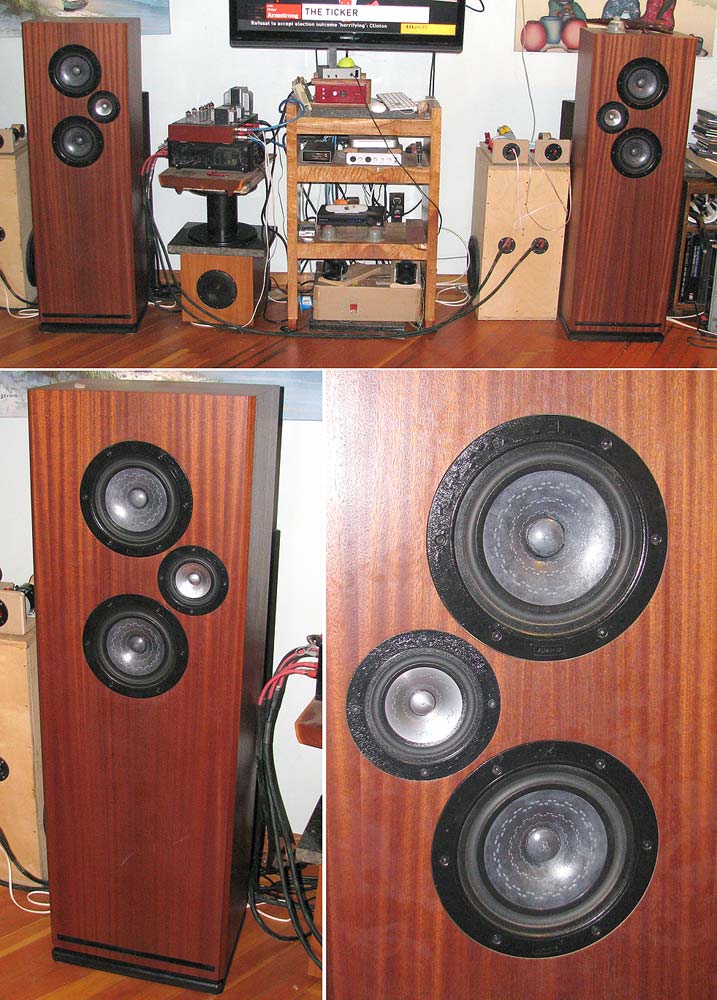
dave

dave
So, is this discussion only about 1st order electrical crossovers using passive components? Just pointing out that 1st order can be done with active crossover as well (and the filter circuit ahead of an amp's near-pure resisitive input can be nothing more than a capacitor).
Also, 1st order electrical crossovers don't yield overall 1st order crossovers, at best might get close, since drivers come pre-equipped with several orders of acoustic rolloff of their own. Probably citing the obvious, but the opposite is often inferred in "1st order" discussions.
Also, 1st order electrical crossovers don't yield overall 1st order crossovers, at best might get close, since drivers come pre-equipped with several orders of acoustic rolloff of their own. Probably citing the obvious, but the opposite is often inferred in "1st order" discussions.
(and the filter circuit ahead of an amp's near-pure resisitive input can be nothing more than a capacitor).
The HP can. I have actually gone in and shrunken the input cap (C3) on my ACAs so as to have a minimum in the way.
1st order electrical crossovers don't yield overall 1st order crossovers, at best might get close, since drivers come pre-equipped with several orders of acoustic rolloff of their own.
Why it is essential to have at least a couple octaves beyond the XO point where both the driver is flat and — for a passive XO) its impedance is too.
dave
In the first scenario there is ideally only a cap and perhaps a resistor on the tweeter. The impedance increase due to temp increase is what it is.So, is this discussion only about 1st order electrical crossovers using passive components? Just pointing out that 1st order can be done with active crossover as well (and the filter circuit ahead of an amp's near-pure resisitive input can be nothing more than a capacitor).
In the 2nd scenario, everything is fixed before the amp and the amp has no option but to perform within the freq. set by the DSP or electric filter. But it has better control (damping).
They are not the same as I see it.
- Status
- Not open for further replies.
- Home
- Loudspeakers
- Multi-Way
- 1st order and drivers.